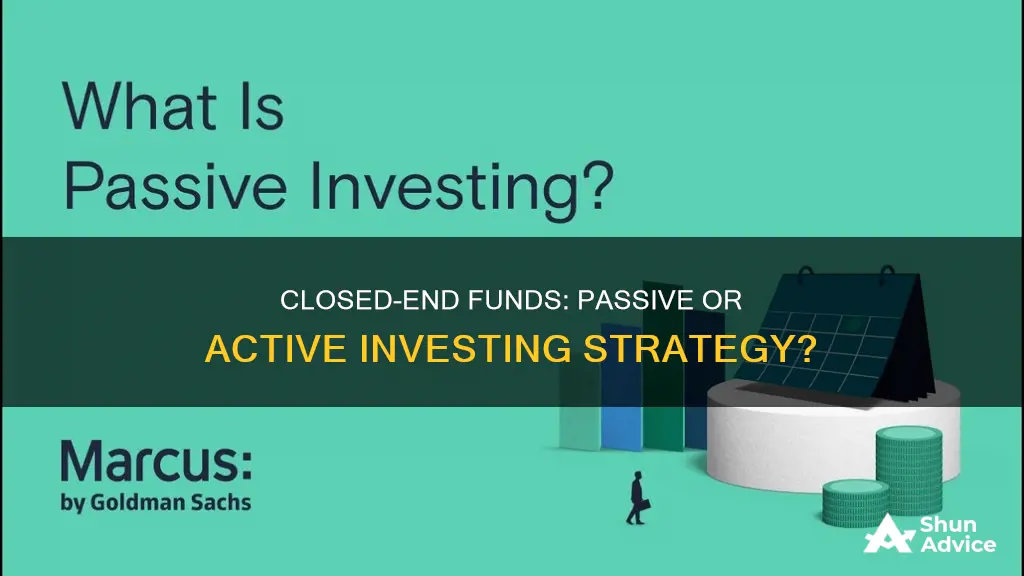
Closed-end funds are a type of investment fund that raises a fixed amount of money through an initial public offering (IPO). Unlike open-end funds, closed-end funds do not continuously offer their shares for sale and do not buy back shares from investors. Instead, they sell a fixed number of shares, which are then traded on the stock market. Closed-end funds can use debt leverage to boost returns, but this also increases risk. They are actively managed and tend to focus on a specific industry, sector, or region. While closed-end funds have been around longer than open-end funds, they are less popular due to their complexity, lower liquidity, and higher volatility.
What You'll Learn

Closed-end funds are actively managed
A closed-end fund raises a fixed amount of money through an IPO, after which it lists a fixed number of shares on a stock exchange. These shares are then bought and sold by investors on the open market. The fund manager does not face reinvestment risk from daily share issuance and is not required to hold excess cash to meet redemptions. This stable capital base makes closed-end funds ideal for investing in illiquid securities.
The price of closed-end fund shares is determined by market supply and demand and may be greater or less than the net asset value (NAV). When the trading price is higher than the NAV, the shares are said to be sold at a premium. Conversely, when the trading price is lower than the NAV, the shares are sold at a discount.
Closed-end funds can use debt leverage to boost returns, but this also increases risk. They tend to pay out higher dividends, partly due to their use of leverage. The ability to use leverage and the potential for higher dividends make closed-end funds attractive to investors. However, the potential downside is greater due to the use of leverage and the structure of closed-end funds.
Overall, closed-end funds are actively managed investment vehicles that offer unique advantages and risks compared to other types of funds.
ETFs and Mutual Funds: Where to Invest?
You may want to see also

They are less liquid than open-end funds
Closed-end funds are less liquid than open-end funds. This is because closed-end funds are launched through an initial public offering (IPO) that raises a fixed amount of money by issuing a fixed number of shares. There is no limit to the number of available shares in an open-end fund, as the fund company can continue to create new shares as needed to meet investor demand.
After the IPO, closed-end funds do not continuously offer their shares for sale. Instead, they trade on a secondary market, such as the New York Stock Exchange or the NASDAQ Stock Market. Shares are bought and sold on the open market, and the fund itself does not issue or redeem shares daily.
Because there is no continuous inflow of new investment capital, closed-end funds are considered to have a more stable capital base than open-end funds. This stability makes closed-end funds a good structure for investing in illiquid securities, such as emerging-market stocks and municipal bonds.
The relative stability of closed-end funds also means that fund managers do not have to hold excess cash to meet redemptions, as they would with an open-end fund. This allows closed-end funds to invest a greater proportion of their assets, increasing potential returns.
However, the limited number of shares available in closed-end funds can make them less liquid than open-end funds. To gain access to a closed-end fund, an investor would need to find someone willing to sell shares or wait for some to become available on the market.
The lack of liquidity in closed-end funds also means that they are less popular than open-end funds and are considered a more complex investment vehicle. They are also more expensive to trade, as each investor must pay a commission to cover the cost of personal trading activity.
Atram Alpha Opportunity Fund: A Guide to Investing
You may want to see also

They are more volatile than open-end funds
Closed-end funds are generally considered more volatile than open-end funds. This volatility is due to several factors, including their pricing structure, use of leverage, and the types of securities they invest in.
Firstly, closed-end funds are priced by the market and trade on stock exchanges throughout the day, like stocks. This means their share price can fluctuate above or below their net asset value (NAV), creating the potential for premium or discount prices. If the trading price is higher than the NAV, the fund is said to be trading at a premium, and investors are paying more than the underlying value of the fund's assets. On the other hand, if the trading price is lower than the NAV, the fund is trading at a discount, and investors can purchase the fund's shares at a lower price. This market-driven pricing structure can lead to more significant price swings than open-end funds, which are priced once daily at the end of the trading day based on their NAV.
Secondly, closed-end funds often use leverage or borrowed money to boost their returns. While this can enhance returns during favourable market conditions, it also amplifies losses during downturns. The use of leverage increases the overall risk of the fund and makes it more volatile than open-end funds, which typically do not use leverage to the same degree.
Additionally, closed-end funds are allowed to hold a greater percentage of illiquid securities, such as emerging market stocks or municipal bonds. These types of securities are more challenging to sell and may experience greater price fluctuations, further contributing to the volatility of closed-end funds.
The combination of market-driven pricing, leverage, and investments in less liquid securities makes closed-end funds more volatile than their open-end counterparts. This higher volatility can present both risks and opportunities for investors, and it is essential to carefully consider these factors before investing in closed-end funds.
Pure Alpha Fund: Strategies for Investing and Maximizing Returns
You may want to see also

They can use leverage to boost returns
Closed-end funds (CEFs) can use leverage to boost returns. This is a key characteristic that sets them apart from other types of funds, such as open-end mutual funds and ETFs. Leverage allows CEFs to borrow or issue preferred shares to increase their investment positions and returns. This ability to use leverage gives CEFs the potential to offer higher returns than their open-fund counterparts.
There are two main ways that CEFs can increase their capital through leverage: issuing debt and issuing preferred shares. By issuing debt, CEFs can borrow money from financial institutions to increase their capital. Alternatively, they can issue preferred shares, which involves raising additional capital by offering a specific type of share with set benefits and rights to investors.
The use of leverage by CEFs is regulated and limited by the Investment Company Act of 1940. This Act allows CEFs to issue debt up to 50% of their net assets and preferred shares up to 100% of their net assets. In practice, the average leveraged CEF has a total leverage of around 33%, meaning for every $1 of net assets, they have an additional $0.33 in leveraged capital.
While leverage can magnify the returns of CEFs, it is important to note that it also increases the volatility of the fund's net asset value. Leverage can lead to higher distribution rates and boost returns, but it can also accelerate losses during downturns. As such, investors need to carefully consider the risks and benefits of leverage when investing in CEFs.
Invest in Nifty Total Market Index Fund: A Comprehensive Guide
You may want to see also

They are less popular than open-end funds
Closed-end funds are less popular than open-end funds for several reasons. One of the main reasons is that they are a more complex investment vehicle that tends to be less liquid and more volatile than open-ended funds. This means that closed-end funds can be riskier and more difficult to buy and sell, which may deter some investors.
Another factor contributing to their lower popularity is that closed-end funds are not followed by Wall Street firms or owned by institutions to the same extent as open-end funds. The research coverage of closed-end funds tends to wane after the initial public offering (IPO), and the shares may languish. As a result, closed-end funds have historically been and are likely to remain a tool primarily used by relatively sophisticated investors.
Additionally, closed-end funds are often actively managed by investment managers who aim to beat the market. This active management comes at a cost, as these funds may charge higher fees than passive investment options, making them less attractive to cost-conscious investors.
Furthermore, the structure of closed-end funds differs from that of open-end funds in that they offer a fixed number of shares and do not continuously create new shares to meet investor demand. This means that investors seeking to purchase shares in a closed-end fund may need to wait until existing shareholders are willing to sell, which can be a less convenient and flexible process.
Lastly, closed-end funds, unlike open-end funds, do not buy back their shares from investors upon request. This lack of a buyback option may be unappealing to investors who value the flexibility of being able to sell their shares back to the fund if needed.
Tips Mutual Funds: When to Invest for Maximum Returns
You may want to see also
Frequently asked questions
A closed-end fund is a type of mutual fund that issues a fixed number of shares through an initial public offering (IPO) to raise capital for its initial investments. Its shares are then bought and sold on a stock exchange, but no new shares will be created, and no new money will flow into the fund.
An open-end fund, such as most mutual funds and exchange-traded funds (ETFs), accepts a constant flow of new investment capital. It issues new shares and buys back its own shares on demand. In contrast, a closed-end fund sells a fixed number of shares during its IPO and never reopens the fund to sell more.
Closed-end funds operate like exchange-traded funds (ETFs) in that they trade throughout the day on a stock exchange. The price of closed-end fund shares is determined by the market and may be greater or less than the shares' net asset value (NAV).
Closed-end funds can provide a steady stream of income, usually on a monthly or quarterly basis. They also have the ability to use leverage, which can lead to greater risk but also greater rewards. Additionally, closed-end funds are all actively managed, allowing investors to benefit from the fund managers' expertise.
Closed-end funds tend to be less liquid and more volatile than open-ended funds. They are also considered a complex investment vehicle and are not as widely followed by Wall Street firms or owned by institutions.







